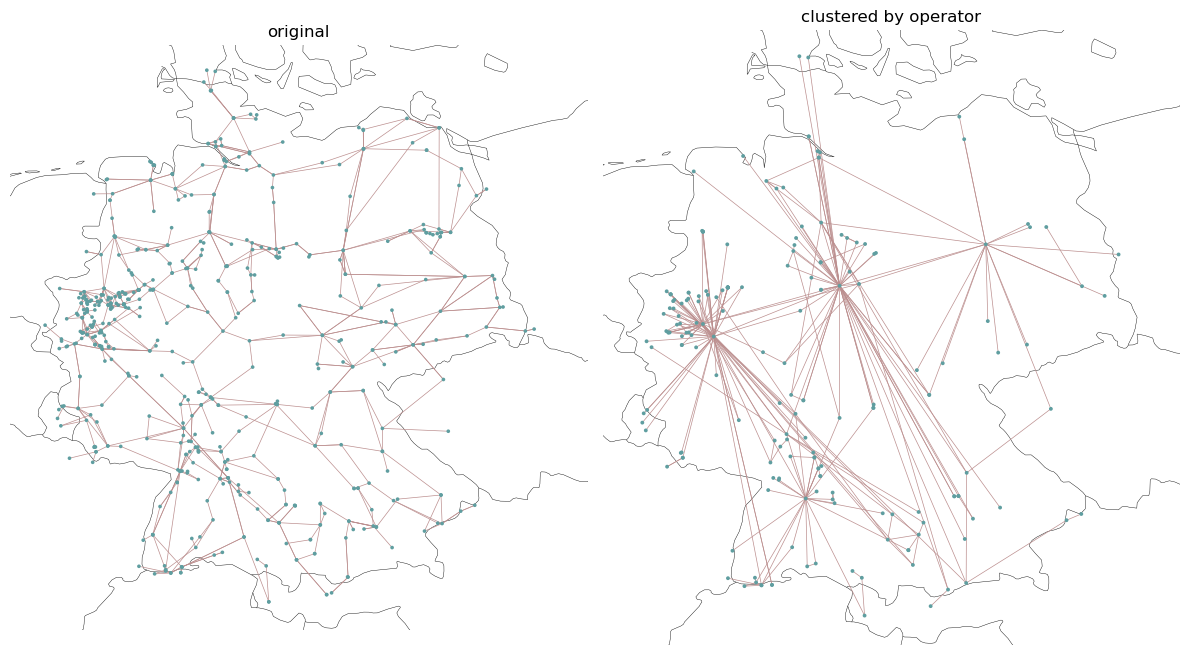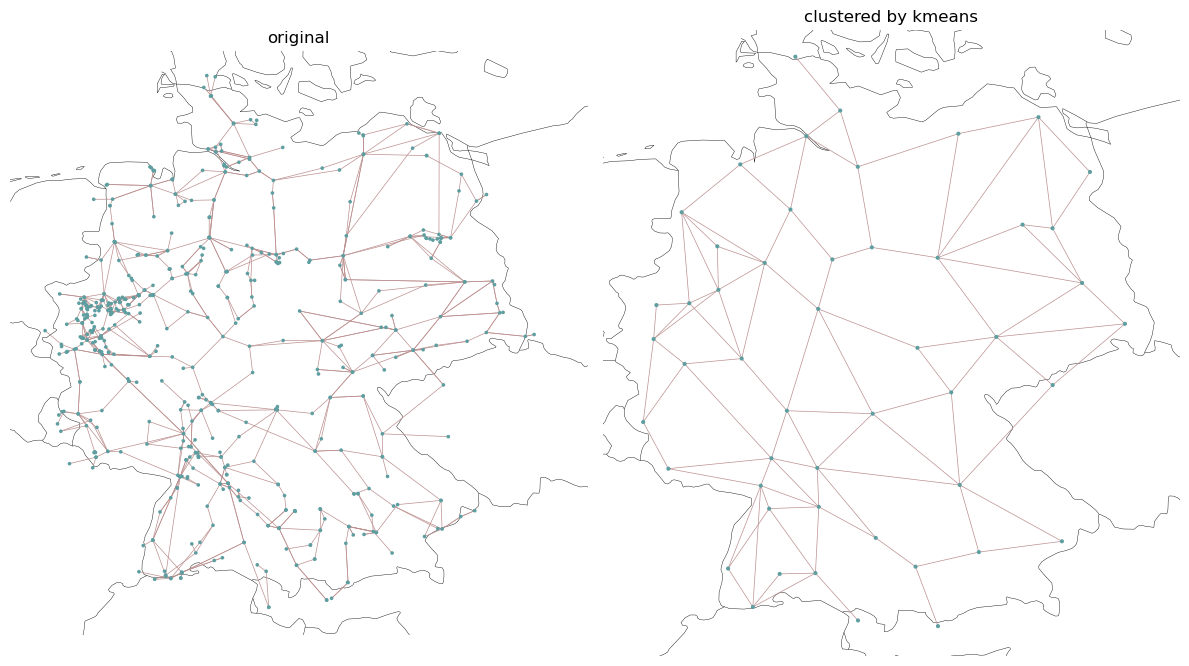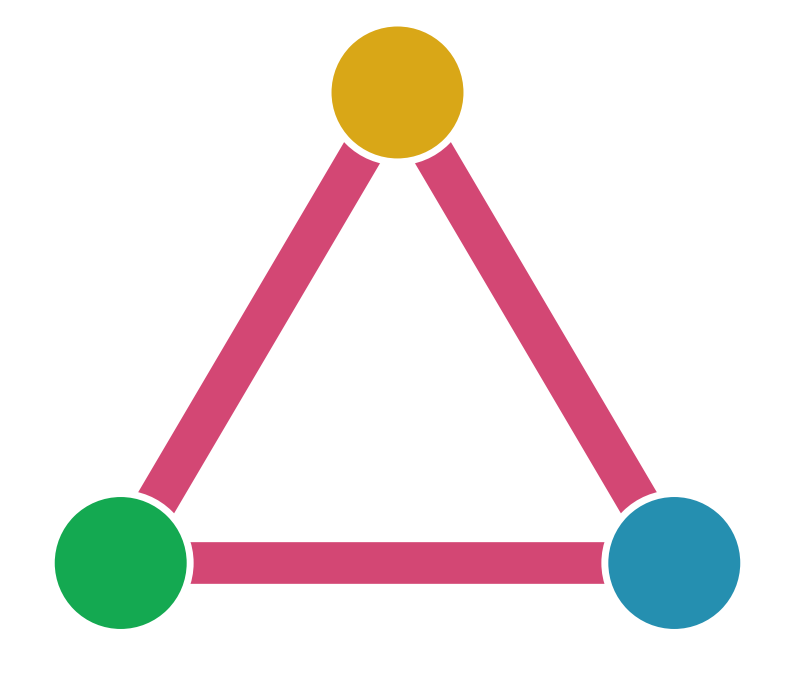Note
You can download this example as a Jupyter notebook or start it in interactive mode.
Network Clustering#
In this example, we show how pypsa can deal with spatial clustering of networks.
[1]:
import pypsa
import re
import numpy as np
import matplotlib.pyplot as plt
import cartopy.crs as ccrs
import pandas as pd
ERROR 1: PROJ: proj_create_from_database: Open of /home/docs/checkouts/readthedocs.org/user_builds/pypsa/conda/latest/share/proj failed
[2]:
n = pypsa.examples.scigrid_de()
n.calculate_dependent_values()
WARNING:pypsa.io:Importing network from PyPSA version v0.17.1 while current version is v0.27.1. Read the release notes at https://pypsa.readthedocs.io/en/latest/release_notes.html to prepare your network for import.
INFO:pypsa.io:Imported network scigrid-de.nc has buses, generators, lines, loads, storage_units, transformers
The important information that pypsa needs for spatial clustering is in the busmap. It contains the mapping of which buses should be grouped together, similar to the groupby groups as we know it from pandas.
You can either calculate a busmap from the provided clustering algorithms or you can create/use your own busmap.
Cluster by custom busmap#
Let’s start with creating our own. In the following, we group all buses together which belong to the same operator. Buses which do not have a specific operator just stay on its own.
[3]:
groups = n.buses.operator.apply(lambda x: re.split(" |,|;", x)[0])
busmap = groups.where(groups != "", n.buses.index)
The clustering routine will raise an error if values in non-standard columns are not the same when combined to a common cluster. Therefore, we adjust the columns of the components and delete problematic non-standard values.
[4]:
n.lines = n.lines.reindex(columns=n.components["Line"]["attrs"].index[1:])
n.lines["type"] = np.nan
n.buses = n.buses.reindex(columns=n.components["Bus"]["attrs"].index[1:])
n.buses["frequency"] = 50
Now we cluster the network based on the busmap.
[5]:
C = n.cluster.get_clustering_from_busmap(busmap)
C is a Clustering object which contains all important information. Among others, the new network is now stored in that Clustering object.
[6]:
nc = C.network
We have a look at the original and the clustered topology
[7]:
fig, (ax, ax1) = plt.subplots(
1, 2, subplot_kw={"projection": ccrs.EqualEarth()}, figsize=(12, 12)
)
plot_kwrgs = dict(bus_sizes=1e-3, line_widths=0.5)
n.plot(ax=ax, title="original", **plot_kwrgs)
nc.plot(ax=ax1, title="clustered by operator", **plot_kwrgs)
fig.tight_layout()
/home/docs/checkouts/readthedocs.org/user_builds/pypsa/conda/latest/lib/python3.11/site-packages/cartopy/mpl/feature_artist.py:144: UserWarning: facecolor will have no effect as it has been defined as "never".
warnings.warn('facecolor will have no effect as it has been '
/home/docs/checkouts/readthedocs.org/user_builds/pypsa/conda/latest/lib/python3.11/site-packages/cartopy/mpl/feature_artist.py:144: UserWarning: facecolor will have no effect as it has been defined as "never".
warnings.warn('facecolor will have no effect as it has been '

Looks a bit messy as over 120 buses do not have assigned operators.
Clustering by busmap created from K-means#
Let’s now make a clustering based on the kmeans algorithm. Therefore we calculate the busmap from a non-weighted kmeans clustering.
[8]:
weighting = pd.Series(1, n.buses.index)
busmap2 = n.cluster.busmap_by_kmeans(bus_weightings=weighting, n_clusters=50)
We use this new kmeans-based busmap to create a new clustered method.
[9]:
nc2 = n.cluster.cluster_by_busmap(busmap2)
Again, let’s plot the networks to compare:
[10]:
fig, (ax, ax1) = plt.subplots(
1, 2, subplot_kw={"projection": ccrs.EqualEarth()}, figsize=(12, 12)
)
plot_kwrgs = dict(bus_sizes=1e-3, line_widths=0.5)
n.plot(ax=ax, title="original", **plot_kwrgs)
nc2.plot(ax=ax1, title="clustered by kmeans", **plot_kwrgs)
fig.tight_layout()
/home/docs/checkouts/readthedocs.org/user_builds/pypsa/conda/latest/lib/python3.11/site-packages/cartopy/mpl/feature_artist.py:144: UserWarning: facecolor will have no effect as it has been defined as "never".
warnings.warn('facecolor will have no effect as it has been '
/home/docs/checkouts/readthedocs.org/user_builds/pypsa/conda/latest/lib/python3.11/site-packages/cartopy/mpl/feature_artist.py:144: UserWarning: facecolor will have no effect as it has been defined as "never".
warnings.warn('facecolor will have no effect as it has been '

There are other clustering algorithms in the pipeline of pypsa as the hierarchical clustering which performs better than the kmeans. Also the get_clustering_from_busmap function supports various arguments on how components in the network should be aggregated.
